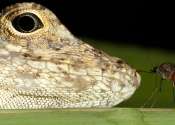The lyrebird synchronizes elements of its mating dance
To woo a mate, the Albert's lyrebird of Australia first chooses a stage of entangled vines, then in performance he shakes the vines as part of his courtship footwork, synchronizing each shake with the beat of his striking ...









